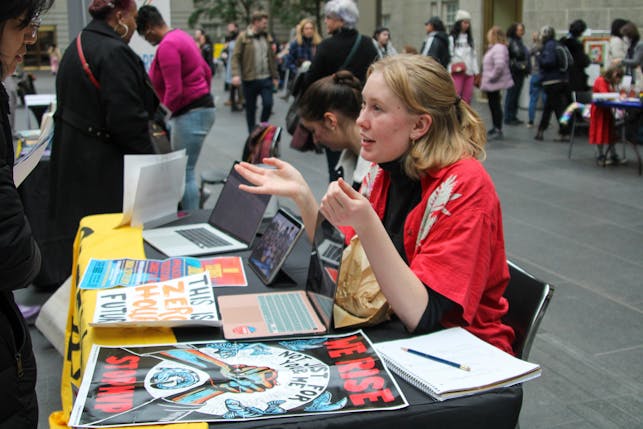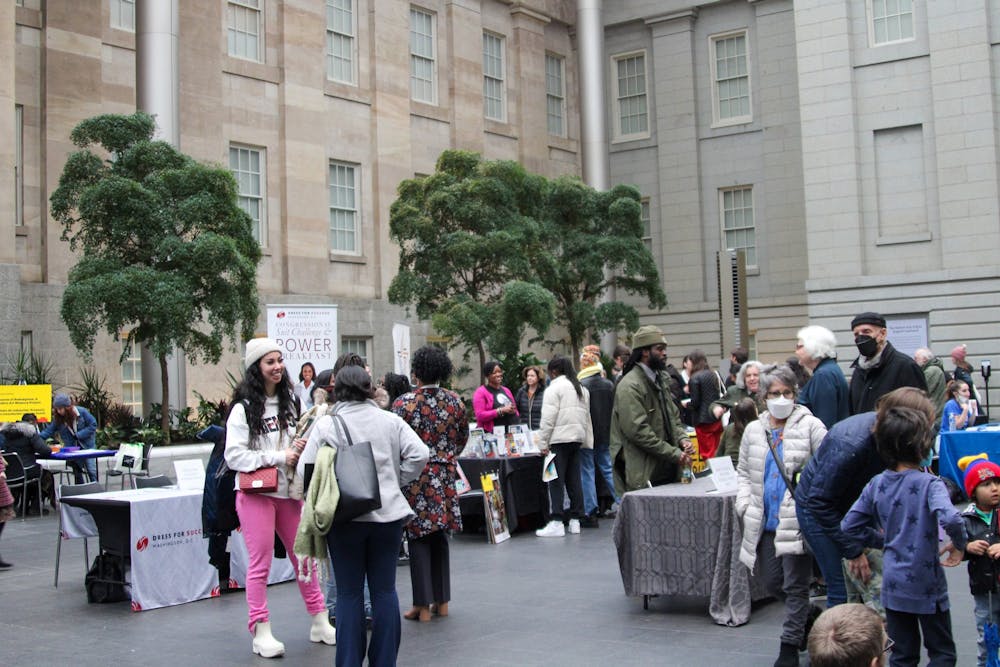Art and plants lined the Kogod Courtyard of the Smithsonian National Portrait Gallery, as artists and activist organizations gathered for the culminating event of the Our Struggle for Justice series. Hosted on Jan. 22, A Day of Action featured artists and social justice organizations who engaged with community members to inspire them to take action.
The event included coloring, printmaking, local artist pop-ups, writing sessions and spotlight tours of the gallery. The family-friendly program of events attracted people of many ages to an open and inviting atmosphere, with music and a stunning setting.
In addition to social justice organizations, representatives from American University and the AU Antiracist Research and Policy Center attended and provided information on their mission and research.
Kayleigh Bryant-Greenwell, the Center’s associate director of operations and outreach, spoke on how she felt the Center’s work relates to art and activism.
In an ever changing landscape of social issues and activism, it’s important to focus on how “policy follows culture” and how culture is a “critical tool of changemaking,” Bryant-Greenwell said. She explained how the Center plans to have programming featuring a local artist seeking to ignite change in the community, who will be announced in the coming weeks.
Running the printmaking station was local artist Alex Huttinger. Guests were able to make their own prints with affirmations such as “I create change in my own community.” Her own program, which is focused on middle and high school students, aims to give children a voice to express what is important to them. While living in the contemporary world, people should “feel empowered and to take action, however that action manifests is really important,” Huttinger said.

Huttinger believes the feelings people have when they see art can become actions and if one were to delve into “any sort of political or activist movement, art has been a central part of it.”
By writing affirmations in the first person, people could handprint “on their own, something that they believe and they can take action on,” Huttinger said.
Other organizations participating in the event included the National Park Service, Jews United for Justice and DC Justice Lab. The National Park Service pop-up featured information on historic sights such as the Frederick Douglass National Historic Site, Jews United for Justice mobilizes Jews and the Jewish community to move DC and Maryland closer to social, racial, and economic justice by advancing campaigns for immediate and concrete improvements in people’s lives for both Jewish and non-Jewish individuals.
advocates for Jewish people living in poor conditions and DC Justice Lab focuses on reforming the legal system. A Day of Action offered a space to form a united front in order to combat social issues by bringing these vital organizations together.
The event not only provided an intersection for social justice issues, but also forms of artistic expression. Artists provided music, visual art, writing and hands-on activities to teach people about the importance of changemaking.
The range of activities allowed every guest to feel included, from people who preferred to sit and color to those seeking information on how to become changemakers themselves.
A Day of Action provided a pathway to get involved in combating critical social justice issues through the intersections of different types of art, and gave guests a space to learn through visual, auditory and hands-on resources.
Events like this can be crucial for changemaking and raising awareness because “art inspires, and art takes a lot of forms,” Huttinger said.
This article was edited by Hannah Langenfeld, Kylie Bill and Nina Heller. Copy editing by Isabelle Kravis, Sophia Rocha and Stella Guzik.
Correction: A previous version of this story contained an incorrect description of Jews United for Justice. This story has been updated to include the correct description of the organization.





